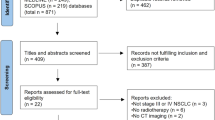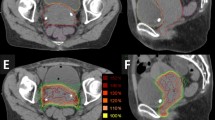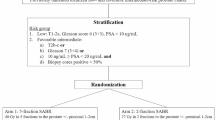Abstract
Background
Pathological diagnosis fails in some pulmonary tumors, although they may be highly suspected to be primary lung cancer. We studied the outcome of stereotactic body radiotherapy for a clinically diagnosed primary stage I lung cancer without pathological confirmation.
Methods
The current study included 37 patients (39 lesions) treated with stereotactic body radiotherapy who were clinically diagnosed with primary stage I lung cancer between August 1998 and April 2009 at our hospital. Pulmonary tumors were highly suspected to be malignant from physical and imaging examinations. Biopsies were performed for 62 % of patients, although malignancy was not pathologically confirmed. In the other 38 % of patients, a biopsy was not feasible. Median age of the patients was 77 years. Median tumor diameter was 20 mm. A total median dose of 48 Gy was prescribed to the isocenter in four fractions. Median follow-up period was 39 months.
Results
The 3-year overall survival, local control, and regional-distant control were 74.2, 94.0, and 68.6 %, respectively. In patients with tumors ≤20 mm, overall survival and regional-distant control were significantly higher than in patients with tumors >20 mm (p ≤ 0.001), whereas no significant difference was observed regarding local control. No grade 3–5 adverse events possibly, probably, or definitely related to the treatment were observed.
Conclusions
Stereotactic body radiotherapy is safe and effective for a clinically diagnosed primary stage I lung cancer when pathological diagnosis is difficult even with repeat biopsies, or a biopsy is not feasible for reasons of the patient’s health condition or wishes.


Similar content being viewed by others
References
Raz DJ, Zell JA, Ou SH et al (2007) Natural history of stage I non-small cell lung cancer: implications for early detection. Chest 132:193–199
Murai T, Shibamoto Y, Baba F et al (2012) Progression of non-small-cell lung cancer during the interval before stereotactic body radiotherapy. Int J Radiat Oncol Biol Phys 82:463–467
Goldstraw P, Crowley J, Chansky K et al (2007) The IASLC Lung Cancer Staging Project: proposals for the revision of the TNM stage groupings in the forthcoming (seventh) edition of the TNM classification of malignant tumours. J Thorac Oncol 2:706–714
Nagata Y, Takayama K, Matsuo Y et al (2005) Clinical outcomes of a phase I/II study of 48 Gy of stereotactic body radiotherapy in 4 fractions for primary lung cancer using a stereotactic body frame. Int J Radiat Oncol Biol Phys 63:1427–1431
Timmerman R, Paulus R, Galvin J et al (2010) Stereotactic body radiation therapy for inoperable early stage lung cancer. JAMA 303:1070–1076
Timmerman R, McGarry R, Yiannoutsos C et al (2006) Excessive toxicity when treating central tumors in a phase II study of stereotactic body radiation therapy for medically inoperable early-stage lung cancer. J Clin Oncol 24:4833–4839
Inoue T, Shimizu S, Onimaru R et al (2009) Clinical outcomes of stereotactic body radiotherapy for small lung lesions clinically diagnosed as primary lung cancer on radiologic examination. Int J Radiat Oncol Biol Phys 75:683–687
Takeda A, Kunieda E, Sanuki N et al (2012) Stereotactic body radiotherapy (SBRT) for solitary pulmonary nodules clinically diagnosed as lung cancer with no pathological confirmation: comparison with non-small-cell lung cancer. Lung Cancer 77:77–82
Verstegen NE, Lagerwaard FJ, Haasbeek CJ et al (2011) Outcomes of stereotactic ablative radiotherapy following a clinical diagnosis of stage I NSCLC: comparison with a contemporaneous cohort with pathologically proven disease. Radiother Oncol 101:250–254
Negoro Y, Nagata Y, Aoki T et al (2001) The effectiveness of an immobilization device in conformal radiotherapy for lung tumor: reduction of respiratory tumor movement and evaluation of the daily setup accuracy. Int J Radiat Oncol Biol Phys 50:889–898
Takayama K, Nagata Y, Negoro Y et al (2005) Treatment planning of stereotactic radiotherapy for solitary lung tumor. Int J Radiat Oncol Biol Phys 61:1565–1571
Matsuo Y, Shibuya K, Nagata Y et al (2011) Prognostic factors in stereotactic body radiotherapy for non-small-cell lung cancer. Int J Radiat Oncol Biol Phys 79:1104–1111
Matsuo Y, Shibuya K, Nagata Y et al (2012) Preliminary report of late recurrences, at 5 years or more, after stereotactic body radiation therapy for non-small cell lung cancer. J Thorac Oncol 7:453–456
Gould MK, Fletcher J, Iannettoni MD et al (2007) Evaluation of patients with pulmonary nodules: when is it lung cancer? ACCP evidence-based clinical practice guidelines (2nd edition). Chest 132:108S–130S
Swensen SJ, Silverstein MD, Ilstrup DM et al (1997) The probability of malignancy in solitary pulmonary nodules. Application to small radiologically indeterminate nodules. Arch Intern Med 157:849–855
Swensen SJ, Silverstein MD, Edell ES et al (1999) Solitary pulmonary nodules: clinical prediction model versus physicians. Mayo Clin Proc 74:319–329
Herder GJ, van Tinteren H, Golding RP et al (2005) Clinical prediction model to characterize pulmonary nodules: validation and added value of 18F-fluorodeoxyglucose positron emission tomography. Chest 128:2490–2496
Kreisman H, Wolkove N, Quoix E (1992) Small cell lung cancer presenting as a solitary pulmonary nodule. Chest 101:225–231
Harmsma M, Schutte B, Ramaekers FC (2013) Serum markers in small cell lung cancer: opportunities for improvement. Biochim Biophys Acta 1836:255–272
Shioyama Y, Nakamura K, Sasaki T et al (2013) Clinical results of stereotactic body radiotherapy for stage I small-cell lung cancer: a single institutional experience. J Radiat Res 54:108–112
Siu LL, Shepherd FA, Murray N et al (1996) Influence of age on the treatment of limited-stage small-cell lung cancer. J Clin Oncol 14:821–828
Kim SK, Allen-Auerbach M, Goldin J et al (2007) Accuracy of PET/CT in characterization of solitary pulmonary lesions. J Nucl Med 48:214–220
Lynch TJ, Bell DW, Sordella R et al (2004) Activating mutations in the epidermal growth factor receptor underlying responsiveness of non-small-cell lung cancer to gefitinib. N Engl J Med 350:2129–2139
Senthi S, Lagerwaard FJ, Haasbeek CJ et al (2012) Patterns of disease recurrence after stereotactic ablative radiotherapy for early stage non-small-cell lung cancer: a retrospective analysis. Lancet Oncol 13:802–809
Grills IS, Hope AJ, Guckenberger M et al (2012) A collaborative analysis of stereotactic lung radiotherapy outcomes for early-stage non-small-cell lung cancer using daily online cone-beam computed tomography image-guided radiotherapy. J Thorac Oncol 7:1382–1393
Eberhardt R, Anantham D, Ernst A et al (2007) Multimodality bronchoscopic diagnosis of peripheral lung lesions: a randomized controlled trial. Am J Respir Crit Care Med 176:36–41
Wu CC, Maher MM, Shepard JA (2011) Complications of CT-guided percutaneous needle biopsy of the chest: prevention and management. AJR Am J Roentgenol 196:W678–W682
Acknowledgments
This work was supported by Grants-in-Aid for Scientific Research from the Ministry of Education, Culture, Sports, Science, and Technology of Japan (20229009).
Conflict of interest
The authors declare that they have no conflict of interest.
Author information
Authors and Affiliations
Corresponding author
About this article
Cite this article
Sakanaka, K., Matsuo, Y., Nagata, Y. et al. Safety and effectiveness of stereotactic body radiotherapy for a clinically diagnosed primary stage I lung cancer without pathological confirmation. Int J Clin Oncol 19, 814–821 (2014). https://doi.org/10.1007/s10147-013-0637-3
Received:
Accepted:
Published:
Issue Date:
DOI: https://doi.org/10.1007/s10147-013-0637-3




